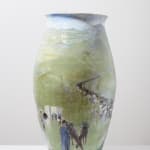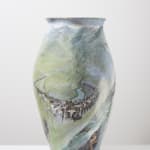Claudia Clare
Ararat to Albania, 2014
87 x 50 cm
34 1/4 x 19 3/4 in
34 1/4 x 19 3/4 in
Sold
Further images
This pot honours the extraordinary work and bravery of three British women in World War 1: Dr. Elise Maud Inglis, Mrs Mabel St. Clair Stobart, and Sergeant Major Flora Sandes...
This pot honours the extraordinary work and bravery of three British women in World War 1: Dr. Elise Maud Inglis, Mrs Mabel St. Clair Stobart, and Sergeant Major Flora Sandes all of whom worked on the Balkan Front and were variously affected by or involved in the Great Serbian Retreat of 1915-16. When Serbia was invaded by German, Austro-Hungarian, and Bulgarian forces in late 1915, retreat was ordered by the Serbian general as the only viable way to survive. It was an exodus of some 355,000 people: men, women, and children, with donkeys, cattle, carts, and whatever they could carry. Approximately 200,000 died in the mountains, with 155,000 reaching the Albanian coast, and eventually crossing the Adriatic to Corfu and Salonica.
Three British Women in the Balkans, 1915
Dr. Elsie Maud Inglis, (1864-1917), shown on the pot at the base, in front of the largest tent, founded the Scottish Women’s Hospitals, (SWH), at the start of WW1. They were staffed by women and operated independently of the War Office. She had offered her services as an experienced doctor in support of the war effort but was brushed off with: ‘My good lady, go home and sit still.’ The SWH set up field hospitals throughout the conflict zones in Europe and Russia and, in 1915, the hospital units were in Serbia to support both soldiers wounded in action on the Balkan front, and the civilian population, which was suffering an epidemic of typhoid.
Above the field hospital is a bullock train bringing supplies to set up one of the field hospitals in Serbia. Mabel St. Clair Stobart, (1864-1952), pictured further round the pot, at the base, with two horses, founded the Women’s Sick and Wounded Convoy Corps, (1912), and the National Women’s Service League, (1914). She commanded the Serbian Relief Fund's Front Line Field Hospital in Serbia and, during the bitter winter of 1915/16, joined the Great Serbian Retreat, leading her staff through the Albanian mountains to the Adriatic coast, without any loss of life.
Also joining the retreat was Flora Sandes, (1876-1956), who was working with the St. John’s Ambulance unit at the time. She had always wanted to be a soldier and resented the limitations of life as a girl and as a woman. She had to join the retreat when enemy forces invaded and, initially, joined the Serbian Red Cross but then enrolled in the Serbian army and fought on the allied side, with the Serbs. She was awarded the Order of the Karadorde’s Star, Serbia’s highest military honour, for bravery in active service, ‘under fire,’ and was promoted to Sergeant Major. She lived most of the rest of her life in Serbia, returning to England only after the death of her husband in 1941. She is pictured at the base of the pot, lit up by fire, during the battle of Monastir, where she was wounded in 1916.
Three British Women in the Balkans, 1915
Dr. Elsie Maud Inglis, (1864-1917), shown on the pot at the base, in front of the largest tent, founded the Scottish Women’s Hospitals, (SWH), at the start of WW1. They were staffed by women and operated independently of the War Office. She had offered her services as an experienced doctor in support of the war effort but was brushed off with: ‘My good lady, go home and sit still.’ The SWH set up field hospitals throughout the conflict zones in Europe and Russia and, in 1915, the hospital units were in Serbia to support both soldiers wounded in action on the Balkan front, and the civilian population, which was suffering an epidemic of typhoid.
Above the field hospital is a bullock train bringing supplies to set up one of the field hospitals in Serbia. Mabel St. Clair Stobart, (1864-1952), pictured further round the pot, at the base, with two horses, founded the Women’s Sick and Wounded Convoy Corps, (1912), and the National Women’s Service League, (1914). She commanded the Serbian Relief Fund's Front Line Field Hospital in Serbia and, during the bitter winter of 1915/16, joined the Great Serbian Retreat, leading her staff through the Albanian mountains to the Adriatic coast, without any loss of life.
Also joining the retreat was Flora Sandes, (1876-1956), who was working with the St. John’s Ambulance unit at the time. She had always wanted to be a soldier and resented the limitations of life as a girl and as a woman. She had to join the retreat when enemy forces invaded and, initially, joined the Serbian Red Cross but then enrolled in the Serbian army and fought on the allied side, with the Serbs. She was awarded the Order of the Karadorde’s Star, Serbia’s highest military honour, for bravery in active service, ‘under fire,’ and was promoted to Sergeant Major. She lived most of the rest of her life in Serbia, returning to England only after the death of her husband in 1941. She is pictured at the base of the pot, lit up by fire, during the battle of Monastir, where she was wounded in 1916.
Join our community of art lovers
Want to be the first to hear our news and get invitations to special events and private views? Leave us your email. We won't sell it, we won't pester you, that's a promise. We just to share with you about art.
* denotes required fields
We will process the personal data you have supplied to communicate with you in accordance with our Privacy Policy. You can unsubscribe or change your preferences at any time by clicking the link in our emails.







